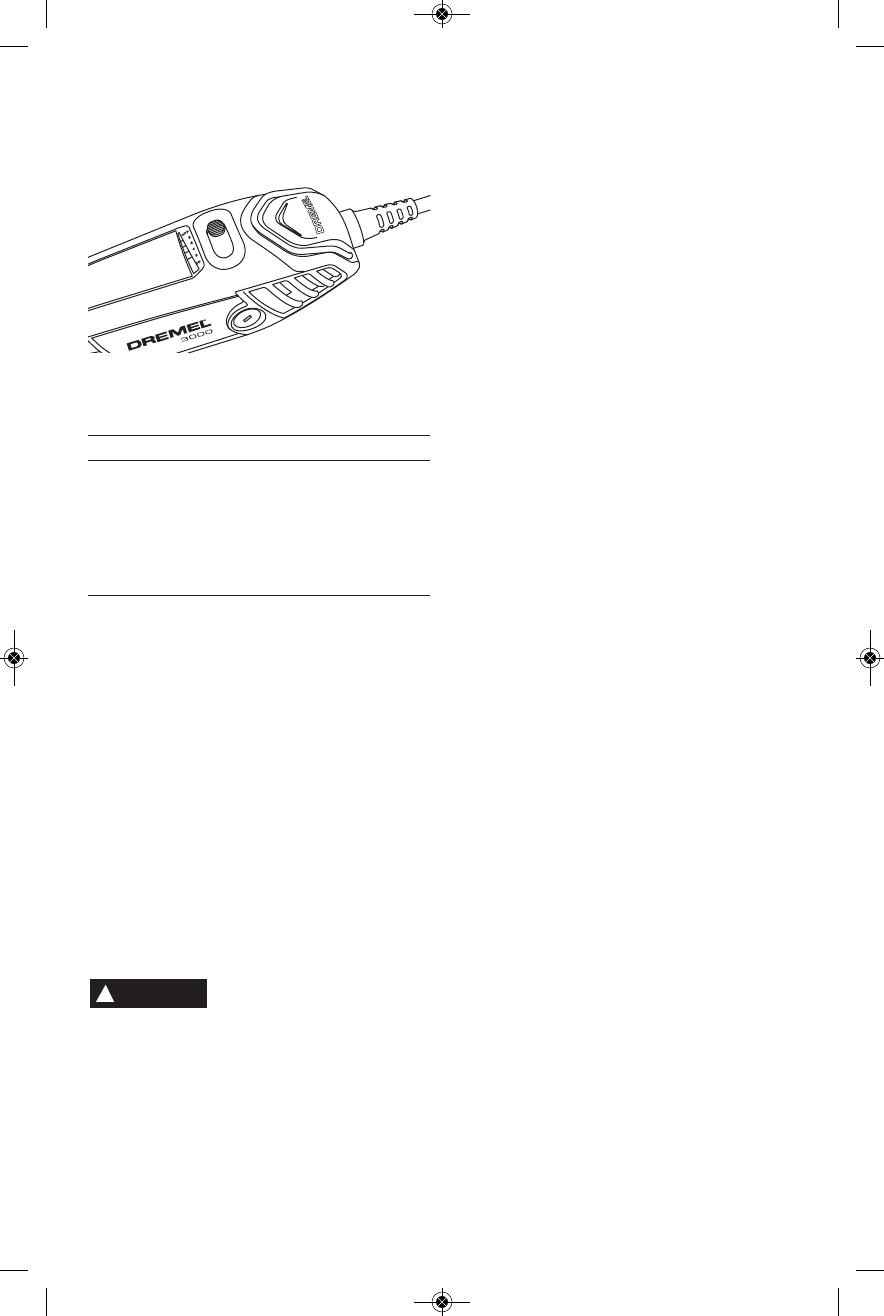
both the correct acces sory and the
optimum speed at a glance.
The speed of Rotary Tool is controlled by
setting this indicator on the housing.
The Settings for Approximate Revolutions
Per Min ute on Rotary Tool Variable Speed
Model 3000.
Switch Setting Speed Range
2 15,000 – 18,000 RPM
*4 19,000 – 15,000 RPM
6 16,000 – 21,000 RPM
8 22,000 – 27,000 RPM
10 28,000 – 32,000 RPM
* 3000 Wire Brush Setting.
Needs for Slower Speeds
Certain materials, however, (some plastics and
precious metals, for ex ample) require a
relatively slow speed because at high speed
the friction of the accessory generates heat
and may cause damage to the material.
Slow speeds (15,000 RPM or less) usually are
best for polishing operations employing the felt
polishing ac ces sories. They may also be best
for working on deli cate projects as “eggery”
work, delicate wood carving and fragile model
parts. (All brushing applications require lower
speeds to avoid wire discharge from the
holder.)
If you need it, single-speed models also
can have speed control by using a Model
221 foot control unit.
Not for use with two speed
or variable speed models
200 or 3000. Use with external speed
control will damage the variable/two speed
electronics.
Higher speeds are better for carving, cutting,
routing, shaping, cutting dadoes or rabbets in
wood.
Hardwoods, metals and glass require high
speed operation, and drilling should also be
done at high speeds.
The point to remember is this: You can do the
great majority of work with the single speed at
its regular speed of 35,000 RPM. But for
certain materials and types of work, you need
slower speeds — which is the reason the
variable speed models are available.
To aid you in determining the optimum
operational speed for differ ent materials and
different accessories, we have construct ed a
series of tables that appear on page 19, 20, 21
and 22. By referring to these tables, you can
discover the recommended speeds for each
type of accessory. Look these tables over and
become familiar with them.
Ultimately, the best way to determine the
correct speed for work on any material is to
practice for a few minutes on a piece of scrap,
even after referring to the chart. You can
quickly learn that a slower or faster speed is
more effective just by observing what hap pens
as you make a pass or two at different speeds.
When working with plastic, for example, start at
a slow rate of speed and increase the speed
until you observe that the plastic is melting at
the point of contact. Then reduce the speed
slight ly to get the optimum working speed.
Some rules of thumb in regard to speed:
1. Plastic and other materials that melt at low
temperatures should be cut at low speeds.
2. Polishing, buffing and cleaning with any
type of bristle brush must be done at
speeds not greater than 15,000 RPM to
prevent damage to the brush.
3. Wood should be cut at high speed.
4. Iron or steel should be cut at high speed. If
a high speed steel cutter starts to chatter —
this normally means it is running too slow.
5. Aluminum, copper alloys, lead alloys, zinc
alloys and tin may be cut at various speeds,
depending on the type of cutting being
done. Use paraffin or other suitable
lubricant on the cutter to prevent the cut
material from adhering to the cutter teeth.
Increasing the pressure on the tool is not the
answer when it is not performing as you think it
should. Perhaps you should be using a
different accessory, and perhaps an
adjustment in speed would solve the problem.
Leaning on the tool does not help.
Let speed do the work!
12
Use only Dremel
®
, high-performance
accessories.
CAUTION
!
DM 2610015339 05-11:DM 2610015339 05-11.qxp 5/12/11 9:40 AM Page 12


















